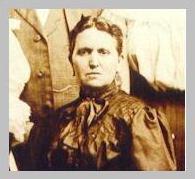
Lucia Regalbuto
circa 1908, New
York.
| Prev Page | Prev Item | Contents | Index | Home Page | Next Item | Next Page |
Page 61 of 107
The Regalbuto Famiglia
of
Sant' Agata Di
Militello
The Regalbuto Famiglia of Sant' Agata Di Militello is part of my family. My grandmother, Maria Modica's mother was Lucia Regalbuto. When we were in Sicily in the year 2000, we were able to see the home she lived in before coming to New York, and I wanted to know more about her. Franco Realbuto, who I was able to locate through a "Sicilian Name Registration" service had done the research for us. We share ancestors beginning with our great-great-grandparents. Franco went through the civil records of not only Sant' Agata Di Militello but the nearby mountain town of San Frantello. The information given below comes from his research.
To me, this part of our family is one of the most interesting because of the communities that they lived in prior to moving to the seaside town of Sant' Agata Di Militello. The name Regalbuto comes from the area that the family probably came to San Fratello from. Regalbuto, Sicily which is in Enna Province, at the navel of Sicily, very close to Mt. Etna - is referred to as "the balconey of Sicily" because it sits on a ledge looking over the mountains and the sea. In 1261, the citizens of a nearby town destroyed Regalbuto which had been settled by the hated Swabians (Germans). The present town of Regalbuto is on the site of an ancient town of the Sikels, who were one of the first people in Sicily - before the Greeks. It was built in 1545. Presently it houses a Museo Civico which contains the polychromatic pottery and ceramics which were renowned in Hellenistic times. There is also a second century ruin named the Mausoleo Romano. As we read in the chapter on our Colloraffi name, places first became an method of identifying a person, when they moved to another community, and then, when surnames were used in records in the mid-17th century in Sicily, some of these "identifications" became the family name.

Lucia Regalbuto
circa 1908, New
York.
To begin with, we know that Luigi Regalbuto was born in San Fratello, Sicily, and died before 1820. His wife, Rosalia Alberti was born about 1776 and died about 1828. The two sons that we know about - Salvatore and Benedetto Regalbuto were both born in San Fratello. For those of us, who once believed that Sicilians are Italians, as I did when I started my research, reading about the interesting town of San Fratello, is a good example of the vast "mix" of cultures that compose the Sicilian people. San Fratello has been referred to as a "Nebrodi Brigadoon". It was actually founded by Queen Adelasia, third wife of Roger I (the one who is burried in Patti) for her countrymen. The town fell down the mountain in 1754 except for the beautiful church which was founded by the Queen. It is called the Santuario dei SS. Fratelli, named after three brothers - Alfio, Filadelfio and Cirino - who were martered.
Another interesting aspect of this town is that it was so isolated that its citizens retain a language that is a dialect that reflects the Norman French. I was told that my great-grandmother, Lucia, told her children that she spoke a French dialect of Sicilian. For those interested in horses, San Fratello is noted for a bread of horse known as "cavalli sanfratellani" which are direct descendants of the Norman horses, which were bread with the local Arabians.
The people of San Fratello were distinct in that they were taller, with light complexions, and often were blue eyed with blond hair. They also retain a very old tradition called "Feast of the Jews". Young men dress in red costumes with masks and blow horns in the street on Maudy Thursday and Good Friday.
In the death record of my great-grandmother, Lucia's, mother - Maria Purpora, who married one of the sons of Luigi Regalbuto, we find that she was born in Termini Imerse. The name Pupora denotes a puppet master, but should be spelled Puporo. Spelling was not perfected in the days when last names were selected. Daphne Phelps, in her book, A House in Sicily, talks about the importance of puppets fo Sicilian history and village life. On page 151, she states, "The tradition of the Sicilian puppets is a long one with its roots in the epics of Ariosto and Tasso. Before the coming of cinemas and televisions, most villages would have a small theater, which would be crowded nightly by peasants and fishermen. Like Elizabethan groundlings, they would boo and cheer and take an active part in the eternal battle between the Cristiani (Christians) and the Pagani (Muslems that invated and ruled Sicily from about 830 until 1071 with the invasion of Roger I). The former were knights coming from all over Europe to fight under the leadership of Charlemagne against the peril from the East. Intriguingly they included Astofo, 'the Englishman, the boldest, the most resolute and the first to fall at Roncesvalles'.
There were the Frenchmen Orlando and Oliviero (Roland and Oliver), and heroes from Denmark, Spain, Germany, and other countries. The serialised plays with the nightly performances could take anything up to thirteen months to complete. The various stories are typical Sicilian mixtures of honour and treachery, cruelty and mercy, valour and cowardice, with pagens converted at the point of a sword. Christians appear, on the whole, to be more bloodthirsty than their enemies as the pile of pagan dead should always be higher than that of the Cristiani until the last great tragedy of Roncesvalles and the death of Orlando."
A traditional puppeteer in Sicilia is quoted as saying, "In order to be a puppeteer you have to be a poet, a sculptor, a painter and a blacksmith" and an actor as well. The puppet shows were a way of telling the history of the Sicilian people and the defeat of the Moors by the Normans. Performances were attended by men and boys, as women were considered "unable to understand" the stories that they told. Once a dying tradition, the Sicilian puppet drams are being revived in Sicily today with a major school of puppetry and therater in Palermo. The puppets are strung on wire with the head able to detach from the body by sliding on the wire, and each puppet is wonderfuly dressed, complete with sword. The Moors have slanted black eyes and hair and the Normans have lighter skin and hair. We saw a wonderful collection of antique puppets in the city museum in Taormina. There are currently active puppet theaters in Palermo and Catania. Perhaps, my love of history comes from the Pupora genes in my body! In fact, I have these genes from two different sources since my great-grandmother, Giuseppa Zingales Botta, who married Domenico Colloraffi, is descended from Maria Pupora's sister, Anna Maria Pupora, who married Biagio Zingales Botta.
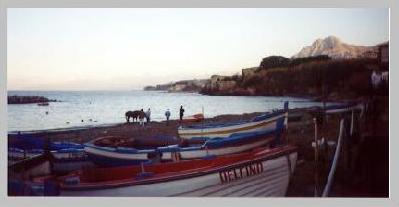
View of the castle
(far right near the shore) at Termini Imerese from the shore of Trabia,
2000.
Termini Imerese, where
Maria Pupora, daughter of Salvatore Pupora and Rosa Schiavo, was born is
another interesting town. The original name of this town was "Thermae Himerenses".
It was a colony of the nearaby Himera and was known for it's hot spring.
It became exporpriated by Carthage. The hot spring was written about in
Greek times by Diodorus. He wrote that they were created by three nymphs
and that no other than the great Hercules, on his way back from fighting
in Erice, was the first to
find comfort and healing
in them. There are several Roman ruins in the town including the remains
of a bath.
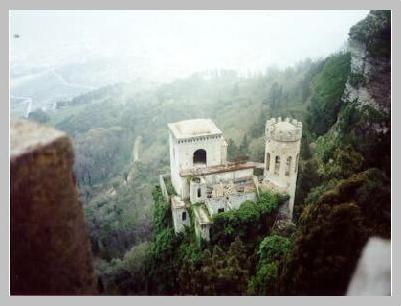
A view of Ennis,
where Venus was born, and Hercules fought.
Maria Pupora's mother's name - Schiavo is another interesting Sicilian history lesson. Often the letter combination of "sch" denotes an Arberesh heritage. The "sch" is related to the "sg" or in Greek - sigma/gamma. The Arberesh can be traced back to the now Albania part of the Balkans and Greece. They tended to be nomad hearders and came from Albania to Greece and from Greece to Sicily, in the 14th to 16th centuries. These were Christians who fled from the Muslim invasions. They were welcomed into Sicily, as they were considered fierce fighters. The Arberesh communicities in Sicily were considered very tribal and these people continued their "greek" traditions into the 19th century. There was an Arberesh community not far from Termini, where Rosa Schiavo was born.
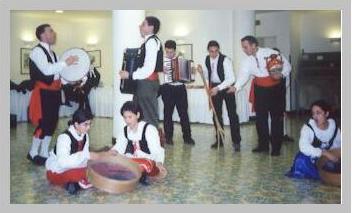
Young people from
a village next to Termini performing a
traditional harvet
folk dance. This hotel, where they are dancing, was once
a community tuna
slaughterhouse from the 15th century. It is possible that
some of my ancestors
participated in the yearly town Matanza* here.
___________________________________________
THE REGALBUTO FAMIGLIA
DI SANT' AGATA
DI MILITELLO
This information
is provided through the many hours of research of
Franco Realbuto
and found in the civil records of
Sant' Agata Di
Militello and San Frantello, Sicilia, Italia
Molto Grazie, Franco!
Luigi Regalbuto was born in San Fratello, Sicily, and died before 1820. He married Rosalia Alberti, b. about 1776 and d. about 1828. They had two children:
1. Benedetto Regalbutto
b. 1793 in San Fratello m. Rosalia Miraglia June 16, 1824. She was born
about 1806.
2. Salvatore Regalbuto
was born in 1798 in San Fratello and died December 30, 1873 in Sant' Agata
Di Militello, Sicilia. He married Maria Pupora on September 28, 1828 in
S.A. di M. She was the daughter of Salvatore Purpora, born bet. 1798 and
1805. His profession is listed as a farm hand. Her mother was Rosa Schiavo,
born bet. 1807-1810 in Termini Imerese, Sicily, and died May 18, 1881 in
S.A. di M. On her death record, her name is recorded as Mariachia - which
is what her namesake - my grandmother, Maria Modica, was sometimes called
and it is recorded on her conformation certificate. The chia ending is
a term of endearment such as "little Maria" and comes from the Greek ending
"kia" meaning small. There are no "K"s in the Italian language.
Salvatore and Maria were married on September 28, 1828 in S.A. di M., Sicily. They had the following children.
1.Lucia Regalbuto was
born July 6, 1854 in Sant' Agata Di Militello, Sicilia and died October
21, 1925 in Cleveland, Ohio. A complete listing of her children, husband,
and family are found in the Modica section of this book, which also includes
her picture.
2. Luigi Regalbuto
was born March 19, 1830 in S.A. di M. and died May 22, 1906 in S.A. di
M.
3. Vincenzo Regalbuto
was b. October 30, 1833 in S.A. di M. and died September 6, 1834 in S.A.
di M.
4. Vincenzo Regalbuto
was b. July 21, 1833 in S.A. di M.
5. Rosa Regalbuto
was b. June 18, 1837 in S.A. di M.
6. Benedetto Re(g)albuto
was b. August 30, 1841 in S.A. di M. and died August 1, 1843 in S.A. di
M.
7. Maria Reg(g)albuto
was b. September 26, 1841 in S.A. di M.
8. Benedetta Re(g)albuto
was b. September 14, 1843 in S.A. di M. and d. April 15, 1904 in S.A. di
M.
9. Giuseppe Re(g)albuto
was b. February 25, 1846 in S.A. di M.
10. Paola Re(g)albuto
was b. February 25, 1846 in S.A. di M.
11. Carmelo Re(g)albuto
was b. October 18, 1831 in S.A. di M.
Maria Regalbuto, b. September 26, 1841 married Liberante Gagliaro, b. September 12, 1836 - in June, 1860 in S.A. di M. Maria's name is spelled Realbuto on the birth records of all of her children, who were all born in S.A. Di M. Their children are:
1. Rosa Gagliardo,
b. November 11, 1865 in S.A. di M.
2. Carmela Gagliardo,
b. February 22, 1868 in S.A. di M.
3. Giuseppa Gagliardo
b. March 5, 1872 in S.A. di M., d. December 15, 1874 in S.A. di M.
4. Giustina Gagliardo,
b. December 5, 1874 in S.A. di M., d. July 28, 1876 in S.A. di M.
5. Giuseppe Gagliardo,
b. May 4, 1871 in S.A. di M.
6. Anna Giustina Gagliardo,
b. February 4, 1880 in S.A. di M.
7. Luigi Gagliardo,
b. May 11, 1882 in S.A. di M.
Benedetta Re(g)albuto was born September 14, 1843 in S.A. di M. and died April 15, 1904 in S.A. di M. She married Giuseppe Brucato, b. January 13, 1829 in S.A. di M. They were married in June, 1865 in S.A. di M. On the birth records of her children - Carmela, Calogero, Calogera, Benedetta, her name is spelled Realbuto, not Regalbuto. Their children are:
1. Carmela Brucato,
b. February 11, 1869 in S. A. di M. m. October, 1886 in S.A. di M.
2. Calogero Brucato,
b. December 4, 1872 in S.A. di M., m. on December 4, 1896 to Rosa Prestianni,
b. February 1, 1880 in S.A. di M.
3. Calogera Brucato,
b. May 5, 1879 in S.A. di M. m. Calogero Parisi in August, 1895 in S. A.
di M.
4. Benedetta Brucato
d. June 13, 1881 in S.A. di M. m. Salvatore Salvo, b. April 18, 1876. Marriage
was on February 10, 1904 in S.A. di M.
Giuseppe Re(g)albuto was born February 25, 1846 in S.A. di m. Angela Cerrito in January 1876 in S.A. di M. It is interesting that VINCENZO COLLORAFFI marries a Cerrito. The Cerrito's are also related, and marry into the MODICA family. More information about this is in the Modica chapter of this book. Their children are:
1. Salvadore Regalbuto
b. March 1, 1876 in S.A. di M.
2. Carmelo Regalbuto,
b. September 12, 1879 in S.A. di M. m. Giuseppa Sansome in February, 1906
in Palermo, Italy.
3. Teresa Regalbuto,
b. November 15, 1881 in S.A. di M., d. November 9, 1882 in S.A. di M.
4. Teresa Regalbuto,
b. July 20, 1884 in S.A. di M. It is believed that she came to the USA
on April 18, 1905.
5. Rosa Regalbuto,
b. June 8, 1887 in S. A. di M. It is believed that she came to the USA
on April 18, 1905.
6. Luigia Regalbuto,
b. March 2, 1889 in S.A. di M.,d. January 5, 1907 in S.A. di M.
7. Luigi Regalbuto,
b. January 10, 1891 in S.A. di M.
8. Lauretta Regalbuto,
b. March 5, 1893 in S. A. di M.
9. Giuseppa Marcellina
Regalbuto, b. March 19, 1895 in S.A. di M., died September 29, 1970 in
California, m. to Antonio Modica on April 25, 1915, son of Ignazio Modica
and Lucia Regalbuto. Lucia is the sister of Giuseppe Regalbuto. Their children
are listed in the Modica section of this book.
10. Guida Maria Giuseppa
Regalbuto was b. January 1, 1898 in S.A. di M. d. January 21, 1908 in S.A.
di M.
Carmelo Re(g)albuto was born October 18, 1831 in S.A. di M. He m. Domenica Brucato in June, 1860 in S.A. di M. She was b. January 1, 1839 in S.A. di M. They had the following children:
1. Giovanni Regalbuto,
b. March 13, 1865 in S.A. di M.
2. Salvatore Regalbuto,
b. September 12, 1862 in S.A. di M. m. Serafina Franchina, b. about 1866.
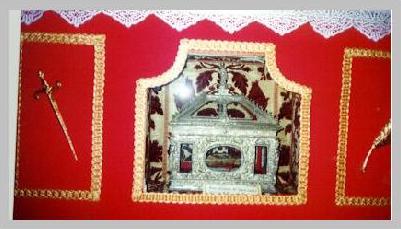
The name - Lucia
- is in honor of Santa Lucia.
My great grandmother
was Lucia Regalbuto.
This is a bone
of Santa Lucia in a Cathedral in Sicily.
Page 61 of 107
| Prev Page | Prev Item | Contents | Index | Home Page | Next Item | Next Page |